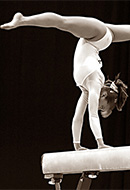Women and sport, a successful alliance
Women's interest in sport continues to grow
The number of women playing sport today, or following sporting events closely, is steadily increasing. This increase is a result of changes that took place in schools in the 1970s, and it is in the 21st century that it is beginning to have a greater impact, with women's sport taking its rightful place both on the field and in the media.

Does the number 261 mean anything to you? If the answer is no, read on: Nowadays it is commonplace to see thousands of girls competing in the world's great marathons, from New York to Berlin via Madrid. But this was not always the case. On 19 April 1967, Katherine Switzer changed history by circumventing the ban on women competing in a marathon. She also did this in the oldest marathon in the world - the Boston Marathon - and she not only ran it, she finished it with a time of 4 hours and 20 minutes despite the organisers’ boycott. Kathrine herself recalled this in a statement to the BBC: "He grabbed me by the shoulders - she refers to Jock Stemple (co-director of the race) - pushed me and tried to take my bib off my chest". That bib number was 261 and from that day on it has been a symbol of equality and women's sport.
Increasing numbers of sportswomen
The presence of female athletes has only grown since then and the gap between men and women in terms of interest in sport has narrowed significantly over the last 50 years. This is one of the conclusions drawn from the latest Women and Sport report by Repucom (Nielsen). Sportswomen such as Yelena Isinbayeva, Serena Williams, Laure Manadou or Megan Rapione have taken over the baton from women took up the baton from pioneering women in sport such as Katherine Switzer, Nadia Comaneci or Larissa Latynina, and today almost 50% of the world's female population is interested in sport. This is thanks, in large part, to having female role models like them, as well as other "new" names such as Simone Biles or Yusra Mardini.
Tellingly, since 2012, women have participated in all categories of Olympic sports at the Games. And all new sports included in the Olympic Games today must contain women's events.
The mass media, first television and then the Internet, have brought sport closer to society, especially to women, since attending sporting events was, for a long time, a forbidden area for women. But what sports do women watch on television? Their tastes differ depending on where they come from. In the US, American football rules; in the UK, tennis; in China, badminton; in Japan, ice skating; and in Mexico, football. In general, disciplines such as tennis, athletics or figure skating arouse more interest among women than men. Motor sports, by contrast, are the least popular.
More and more girls are playing sports
Different members of the international sports ecosystem have joined forces to continue taking important steps in the advancement of gender equality, many of them from UN Women's Sport for Generation Equality coalition. Thus, in order to encourage especially the participation of girls and young women, organisations are taking actions such as:
![]() Developing their grassroots sport for young people and girls.
Developing their grassroots sport for young people and girls.
![]() Implementing gender equality strategies.
Implementing gender equality strategies.
![]() Creating protection policies.
Creating protection policies.
![]() Increasing women's participation in leadership and at all levels of the profession.
Increasing women's participation in leadership and at all levels of the profession.
![]() Increasing the allocation of resources for women's sport.
Increasing the allocation of resources for women's sport.
![]() Providing better and more media coverage and marketing free of gender bias.
Providing better and more media coverage and marketing free of gender bias.
![]() Promoting women's achievements.
Promoting women's achievements.
According to the Women and Sport [PDF] report, women who participate in sporting activities at school are 76% more likely to remain interested in sport for the rest of their lives. In the 1970s and 1980s, girls' participation in such activities increased and it is these women who, over time, have turned the tide. And the trend will continue because it is now women who are encouraging their daughters to take up sport. Here, too, the differences between countries are considerable. In China, only 14% of women aged 16-29 did not play sport at school, a figure that contrasts with Japan, where up to 84% stayed away from sport.
Percentage of women’s interest in sport across two generations

Women under 50

Women over 50
- Very interested
- Interested
- A little interested
- Not interested at all
Percentage of men and women
who sometines or regularly watch specific sports during their respective on-seasons
United Kingdom
- 1
- 2
- 3
- Women
- Tennis 68%
- Football 66%
- Athletics 61%
- 1
- 2
- 3
- Men
- Football 85%
- Tennis 58%
- Motorsport 56%
Germany
- 1
- 2
- 3
- Women
- Football 58%
- Athletics 51%
- Motorsport 47%
- 1
- 2
- 3
- Men
- Football 90%
- Motorsport 66%
- Athletics 53%
United States
- 1
- 2
- 3
- Women
- American football 77%
- Baseball 56%
- Basketball 54%
- 1
- 2
- 3
- Men
- American football 89%
- Baseball 70%
- Basketball 68%
Mexico
- 1
- 2
- 3
- Women
- Football 82%
- Figure skating 72%
- Basketball 61%
- 1
- 2
- 3
- Men
- Football 91%
- American football 72%
- Basketball 70%
China
- 1
- 2
- 3
- Women
- Badminton 91%
- Basketball 80%
- Tennis 78%
- 1
- 2
- 3
- Men
- Basketball 88%
- Badminton 86%
- Tennis 76%
Source: Women and Sport Report from Repucom.
 SEE INFOGRAPHIC: Women and sport: growth statistics [PDF]
SEE INFOGRAPHIC: Women and sport: growth statistics [PDF]
What drives women to play sports?
Sport has demonstrated in recent years its enormous capacity to boost the empowerment of women and girls and advance gender equality , as explained by the UN women's secretariat. Sport mobilises the global community and targets youth; it unites across national barriers and cultural differences; it is a powerful tool for sharing the values of teamwork, self-reliance and resilience; it has a multiplying effect on their health, education and leadership development; it contributes to self-esteem, creates social connections and challenges harmful gender norms.
, as explained by the UN women's secretariat. Sport mobilises the global community and targets youth; it unites across national barriers and cultural differences; it is a powerful tool for sharing the values of teamwork, self-reliance and resilience; it has a multiplying effect on their health, education and leadership development; it contributes to self-esteem, creates social connections and challenges harmful gender norms.

Women at the Olympic Games
Find out about the history of women in the Olympic Games and key figures.

Famous female athletes in history
Women's interest in sport continues to grow. Find out how!

Pioneering women in other sectors
Many women have broken barriers to shine. Discover some of them!

Women's football
Iberdrola, a worldwide sponsor of women's football.









